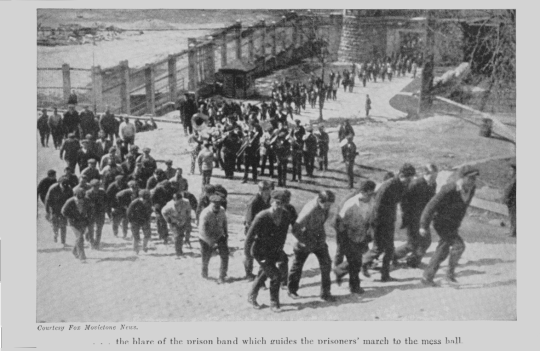#lewis lawes
Text

"By 1924, progressive prison reformers were openly lamenting the atrophy of public interest in the cause of humanitarian prison reform; two years later, many noted that this inattentiveness had turned to outright hostility toward a number of the foundational principles of progressive penology. That year, under the leadership of Republican Crime Commissioner, state Senator Caleb Baumes, the Republican-dominated New York state legislature breathlessly enacted twenty two crime bills that, together, had far-reaching implications for offenders and life in the state’s prisons. Popularly known as the "Baumes laws," the new legislation created new crimes, retrenched procedural protections for the accused, abolished the good-time system under which good behavior in prison reduced a convict’s sentence, reintroduced mandatory sentencing, and drastically raised maximum sentences for a number of serious crimes. (For example, the maximum sentence for first-degree robbery was raised from twenty years to life imprisonment and, for second-degree robbery, from ten to fifteen years). Most infamously, the Baumes laws strengthened the state’s 1907 habitual criminal law by providing that any person convicted of a fourth felony "shall be sentenced to life imprisonment without possibility of parole or commutation of sentence."
The passage of these laws had little, if any, appreciable impact upon New York’s supposed crime wave (although, according to an outraged Clarence Darrow, they contributed significantly to a national "hate wave" and constituted an egregious assault upon civil liberties). The laws did, however, play a catalytic and, in many ways, deeply ironic role in the history of legal punishment. In effectively abolishing indeterminate sentences and providing that upon a fourth conviction for felony crime a convict would automatically receive a life sentence without possibility of parole or commutation, the Baumes laws threw a large spanner into the disciplinary machinery of the prisons. As noted earlier, the logic of the new disciplinary system held that prisoners would render up obedience in exchange for earlier freedom and, in the meantime, the pleasures and releases afforded by movies, athletics, tobacco, and various other sublimating activities. The Baumes laws, however, challenged three of the principal presuppositions of this penology: namely, that all but a small minority of convicts would eventually leave prison; that no hardened core of embittered, hopeless "lifers" would accumulate in the prison; and that every prisoner, in theory at least, enjoyed the possibility of early discharge through good behavior. These were important structural preconditions for penal managerialism’s system of incentive; without them, convicts had much less reason to cooperate with the administration and far more incentive to rebel.
As well as tinkering with the incentive system of managerial penology, the Baumes laws breached a principle of justice dear to the hearts of prisoners: equality of sentencing (wherein the same crime got the same time, regardless of the convict’s record). As Warden Lawes understood very well, equality of sentencing, and more especially prisoners’ perception that the criminal justice system treated convicts more or less equally, was essential to the task of maintaining the good morale of the prisoners – and, hence, the good order of the prison. The "four strikes” law engendered the situation by which a person convicted of four burglaries would be automatically incarcerated for life without possibility of parole or commutation, whereas a person with a conviction for manslaughter (or even two previous convictions for manslaughter) would more likely serve a sentence of twenty years. This assault upon equality of sentencing prompted Lawes to complain to a reporter from the New York Times that the Baumes laws quite perversely provided robbers an incentive to kill their victims and plead guilty to what was now the lesser charge of manslaughter. The third problem posed by the Baumes laws was that their provision for longer sentences and mandatory lifetime sentences for fourth-timers threatened to trigger a rapid increase of the prison populations in prisons that were already putting two, and sometimes three, men in cells measuring just six feet by five feet. The Baumes’ laws seemed very likely to overfill the prisons; moreover, the surplus of prisoners would consist not in the usual run of convicts, but in an aggrieved and hopeless class of convicts who considered themselves profoundly wronged by the law.
Once the Baumes laws went into effect in July 1926, prison populations began to grow quite steeply and prison conditions began to degenerate. The initial source of the increase was not a rapid upswing in new commitments, but rather a decrease in the release rate, and people entering with longer sentences to serve: Fewer people were committed to New York’s state prisons and reformatories in 1927 than in 1926, but New York’s state prison population nonetheless increased quite steadily in the following years, as the first to be sentenced to life under the four strikes law began to trickle into the system. Every year after 1927, commitments to the state prisons increased dramatically. In 1928 and 1929, the population of the four main state prisons increased over eleven percent, or just over five percent per annum. Cellblocks that already held a full complement of prisoners overflowed: By 1929, New York’s male state prison population exceeded cell capacity by almost 1,000 men – or twenty percent – of the prisons’ capacity. Although, in and of itself, the increase in the sheer number of prisoners exerted considerable pressure on the prison order, the particular source of the surplus population was even more significant. Just as Lawes had warned, the prisons began accumulating miserable and volatile lifetime prisoners, and a larger mass of prisoners serving longer sentences for lesser crimes. At Sing Sing an influx of Baumes "lifers" increased the total number of prisoners serving life terms by sixty-five percent in just sixteen months. These were precisely the prisoners whom Lawes warned would have no hope for the future and who, in their mounting desperation, were likely to resist, escape, or even attempt to overthrow prison authorities.
Prisoners at Auburn and Clinton, the prisons to which the majority of repeat and lifetime convicts were committed, became increasingly restive in these years. Audacious escape attempts multiplied: A train-load of men being transferred out of overcrowded Sing Sing to Clinton in late 1927 attempted a mass break in transit (the attempt was foiled). The same year, Clinton authorities intercepted a cache of weapons, ammunition, and maps intended for a group of prisoners, and learned of plans for a large-scale prison break. In another spectacular, if equally unsuccessful, escape attempt, three convicted felons held in Manhattan’s "Tombs" jail used smuggled pistols to shoot their way to freedom; along the way, the warden and head keeper were shot dead, and two of the prisoners turned their weapons on themselves rather than face trial under the new laws. The rate of smaller scale escape attempts also inclined – both at the state prisons and at police jails, where accused offenders awaited trial under the new sentencing laws or transfer to a state prison.
Under the strain, the critical mechanisms of managerial prison discipline – sublimation and the activation of a convict’s desire to be free – threatened to jam. The respective state prison wardens took immediate steps to head off trouble: All scaled-up security and most rolled back privileges. In the midst of the statewide spate of escape attempts, the warden of Great Meadow abolished the honor league and put the convicts to work building a high wall around that previously low-security prison. At Auburn, warden Edgar S. Jennings abandoned the basic managerial approach and began to crack down on various prisoner-organized activities. Anxious to assert his authority, Jennings moved, in 1927, to cancel the established celebrations surrounding various national and ethnic holidays in the prison. Failing to recognize that such affairs could be restructured in such a way as to stabilize rather than undermine the prison order, Jennings insisted they were inherently disruptive, unruly events: "The Irish-Americans wish to celebrate St. Patrick’s Day; the colored men, Emancipation Day; the Italians, Columbus Day; the Polish, a Polish Day; and the Hebrews, a special feast day," he exclaimed in an exasperated memo to the Superintendent of Prisons in 1927. "The rivalry between those few different groups to have a more successful performance, bigger acts, and more entertainment has developed a condition that is very unsatisfactory," he went on: The celebrations had to be curtailed. The warden proceeded to abolish half-holidays, lock-down the prisoners in their cells on Saturday nights, cancel special suppers, reinstate the punishment cells, and suspend various privileges. As warden Jennings cracked down, prisoners began defying orders, the warden punished alleged troublemakers with ever longer periods of isolation in the punishment cells, and the keepers turned against both the league and a warden who seemed incapable of reining in the prisoners. Clinton’s warden rolled back privileges and segregated suspected troublemakers in the punishment cells.
At Sing Sing, Lewis E. Lawes took a different tack. Like his colleagues up-state, he quietly tightened security at the prison (chiefly, by suspending visiting, reinforcing the prison wall, and mounting machineguns on the watchtowers). But, at the same time, he stepped up his program of morale-building. Lawes redoubled his efforts to demonstrate his responsiveness to the prisoners and their needs. As well as maintaining established programs, he gave the entire prison a special chicken dinner, motion pictures, and live music on Thanksgiving; likewise, on Christmas day, he and his wife provided the men with movies, a special meal, and small "favors" and gifts. At the request of one "lifer" he ordered the stars and stripes hoisted within sight of the cellblock, in honor of the 300-odd Great War veterans who resided there. He also extended the new psychiatric program at the prison, describing the program as a great asset to prison administration. Finally, he made a number of public statements in which he made it clear, not only to the general public but to the prisoners, that he was unequivocally opposed to the Baumes laws and that he felt considerable empathy for the convicts. All men, including prisoners, had their breaking point, Lawes declared in a 1928 radio address on Collier’s hour (which was broadcasted live to the men of Sing Sing): All were subject to temptation.
The deteriorating situation in the prisons came to a head in the summer of 1929. At Clinton prison, on July 22, 1929 (almost exactly three years after the Baumes laws had gone into effect), 1,300 prisoners attempted to storm the walls and burn down the buildings. Before a hastily convened force of keepers and volunteers restored order, three prisoners were shot dead and dozens more, peppered with buckshot. Governor Franklin D. Roosevelt indicated, following the Clinton rebellion, that no executive action was needed. However, within days of the Clinton rebellion, the escalating power tussles at Auburn erupted into open conflict. A full-scale uprising broke out. Auburn prisoners rioted for several days, razing the wood and furniture shops, foundry, dye house, store house, and commissary and seriously damaging five other prison buildings. Order was restored only after the National Guard was called out. Realizing that these riots were probably not isolated incidents, after all, Roosevelt called for an immediate and wide-ranging investigation of the prisons, and for a review of the Baumes laws (which he strongly inferred were responsible for the recent unrest in the prisons).
Using a technique he would later put to use as President of the United States, Roosevelt convened a series of “parleys” at his Manhattan residence, calling together a wide array of experts, including prison wardens, members of the National Committee on Prisons & Prison Labor, and criminologists, to discuss the prison situation. As the investigation got underway in earnest, Auburn prisoners acted a second time to register their frustration and anger at the Baumes laws. In December 1929, a handful of Auburn prisoners rebelled once again, this time taking warden Jennings hostage and calling for the release of their comrades from the punishment cells. When the authorities refused to cooperate, the prisoners put that marvelous technology of penal managerialism – the radio system – to work, broadcasting a general call to riot, and successfully precipitating a second, full-fledged prison uprising. The National Guard was called out once more. By the time order was restored, the principal keeper and eight convicts were dead, four guards and two convicts were seriously wounded, and dozens of convicts and guards had been gassed. (Warden Jennings survived).
...
Notably, convicts at the most infamous of American prisons – Sing Sing – did not riot. Although it was the case that Sing Sing had not borne the full brunt of the four strikes laws (largely because it received mostly shorter-term first and second-time offenders) it was, nonetheless, more overcrowded than at any other point in its history, and it did have a small, but rapidly growing, population of Baumes "lifers." Like his colleagues, Lawes had tightened security as unrest among the prisoners had mounted after 1926. But, unlike the others, Lawes had extended and reinforced the morale-building disciplinary system and sought, at every turn, to shore up the "square deal" between prisoners and keepers.
Upon hearing rumors that Sing Sing prisoners might follow Auburn’s example and riot, Lawes deftly deployed a combination of force and empathy to maintain control of Sing Sing. He immediately talked with the Sing Sing convicts and solicited their grievances. While consulting with his wards, he also made it clear that any collective action or protest on the convicts’ part would be met with swift and certain repression. An overwhelming show of force punctuated this threat: Within hours of the December uprising at Auburn, three companies of the National Guard went on alert at Sing Sing, a small U.S. naval vessel sailed up the Hudson from New York City, and three more Gattling machine guns appeared on the high wall of the prison. As convicts witnessed this show of force, Lawes quietly suspended the Mutual Welfare League’s annual Christmas show on the grounds that a large gathering of convicts might be volatile. As Lawes later told the story, when the league’s leaders voted to resign in protest and rumors began circulating to the effect that a riot was imminent, he accepted their resignations and then promptly informed the prison population that the former organizers had resigned and were on their way to Clinton prison. But even at this point, Lawes did not abolish the league or institute a prisonwide crack-down, as Jennings had done at Auburn. Rather, he worked with the league’s new leaders (who quietly "agreed" with Lawes that the show, indeed, ought to be cancelled, after all) to calm the prison. Rumors of imminent riot subsided. Some sixteen years after the scandalous rebellion of 1913, and as prisons around the state and in other parts of the country erupted in protest, Lawes had enforced the good order of Sing Sing. Even more critically, he had been seen to have done so.
Rather than undermining the penal managerial model of imprisonment, the riots of 1929 indirectly facilitated its consolidation and extension throughout New York’s state prison system. That the Baumes laws had very likely precipitated the Auburn and Clinton prison riots was not lost on Governor Franklin D. Roosevelt; nor did Roosevelt fail to notice Sing Sing’s relative calm and Lawes’s apparently adept handling of the unrest there. In a confidential memorandum to Lawes, Roosevelt sought his advice and, in particular, his views on the Baumes laws’ impact on prison order. A series of official investigations further called into question both the efficacy and the justice of the Baumes laws and cast a very positive light on Lawes and his well-worked-up model of prison administration.
Following the December riot at Auburn, a hastily convened commission headed by Colonel George F. Chandler (former Superintendent of the New York State Police) scrutinized not only the actions of prisoners, but prison conditions and the conduct of the warden, guards, police, and troopers. In his report, Chandler condemned Auburn as an overcrowded prison full of ill-disciplined, underfed convicts and declared that a small group of "desperate" longterm convicts (of the sort generated by the Baumes laws) had taken over the Mutual Welfare League (MWL) and were more or less running the prison. His objection, critically, was not that the convicts were attending entertainments but that the warden had suffered the MWL to become a thuggish gang under the tutelage of the long-term men. (Chandler wrote: "These League officers have police powers, administer punishments, order privilege taken away or granted, run entertainment once or twice a year for which they collect money from the general public who attend, and run a baseball club where male outsiders may attend." Moreover, the convicts ran the telephone switchboard, assisted in mail handling and the cleaning of the offices, guard rooms, and hallways, which, Chandler objected, compromised security.) He concluded by recommending that the overcrowding of the prison be relieved and the Auburn MWL, abolished.
In a separate investigation, Joseph M. Proskauer, an associate justice of the Supreme Court of New York, affirmed these findings but was far more explicit in placing the blame for the riots squarely on the shoulders of the Baumes laws. Proskauer urgently recommended that Governor Roosevelt undertake "fundamental and drastic reform" of the state’s penal system. The Superintendent of Prisons, Raymond Kieb, also criticized the Baumes laws, and recommended the restoration of compensation time. He publicly declared: "(i)t was the strongest instrument the office had for the preservation of law and order in the prisons, as each [convict] knew that behavioristic [sic] deviation led to time forfeiture and delayed the date the prisoners might be granted the privilege of again being free." Finally, the National Society of Penal Information (whose membership was composed of veteran progressive reformers) issued a report laying the blame for the first two New York rebellions on the new sentencing laws, the curtailment of the good-conduct system of early release, and the retrenchment of parole.
In 1930, Roosevelt proceeded to act on these recommendations. He and the Superintendent of Prisons consulted with the wardens about how best to rebuild discipline at Auburn and in the system more generally: Warden Lawes’s Sing Sing was to serve as the basic model of reform. Notably, prison industries – which, just a few years earlier, had been the object of intensive discussion – were given very little emphasis. In announcing the appointment of two prison planning committees (one on the "segregation" of various classes of prisoners and one on prison industries), Roosevelt indicated that putting prisoners to productive labor would most likely not be part of the solution: Noting that "an idle prisoner becomes a brooder and only too often eventually a plotter" he suggested that "trade schools rather than ... factories" might be established in the prisons. Instead, New York’s prison reforms concentrated on segregating various classes of prisoners, repealing the Baumes sentencing laws, and, slowly but surely, applying the principles of Lawes’ managerial penology across the entire state prison system. Roosevelt announced a $30 million program for the improvement of prison conditions, athletics and exercise programs, education, manual training, and the systematic segregation of various classes of prisoners. Notably, when Roosevelt discussed the program he remained silent on the topic of prison industries.
Over the next few years, the principles of the sublimation of prisoners’ emotions through a variety of mostly nonlaboring activities, the privilege system, and the occasional show of uncompromising force, were generalized to the entire state prison system. Although, at Auburn, the MWL was abolished (as per Roosevelt’s request), the recreational and educational activities its members had organized were eventually reinstituted under the auspices of the state, much as Chandler had recommended. On Lawes’s insistence that good food was an important "aide to morale," the quality of prison rations was improved all round. Psychiatrists were hired for each prison and proceeded to play an important role in the assessment of those convicts thought to pose a risk to the prison’s security. Sing Sing psychiatrist, Bernard Glueck’s, taxonomy of mental health was adapted to these ends; in all the prisons, the psychiatrists’ primary task was that of adapting petulant, troublesome, or depressed convicts to prison discipline and identifying for segregation (or exile to Clinton) those deemed to be security threats. Penal managerialism’s need for guards who would resort to psychological, rather than corporeal, means of managing prisoners, was implicitly recognized in the planning and execution of the state’s first guard training programs and the New York State Training School for Guards at Wallkill prison (opened in 1936). Finally, in 1931, at the recommendation of the State Commission of Correction, and with the vocal support of Lawes and Roosevelt, the New York legislature repealed several of the Baumes laws: Most critically, lawmakers reinstituted one of the cornerstones of managerial penology – the good-time compensation plan, under which good behavior was to be rewarded by early release. A year later, Roosevelt signed into law a bill that repealed the mandatory life sentence that another Baumes law imposed on fourth-time offenders: Persons convicted of a fourth felony were now subject to a minimum sentence of fifteen years in prison rather than the mandatory sentence of life.
As part of this general overhaul of the state prison system, Roosevelt also established a State Commission on Prison Administration and Construction, charging it with the task of planning and building six new prisons. The state’s second great wave of prison building soon followed, and in four years, five new state prisons were opened (Attica, Bedford Hills, Coxsackie, Wallkill, and Woodburne). All were to be administered according to much the same managerial principles prescribed for the other prisons of the state. Critically, prison labor was not to be used in the construction of these new facilities: William Green, the President of the AFL, successfully lobbied New York state, and the federal government, to restrict the use of penal labor in public works on the grounds that convicts were provided with "food, clothing, and shelter" while, as the Great Depression wore on, free labor was going without. Prisons were "public works" and as such, it was agreed that free labor, rather than convict labor, should build them."
- Rebecca M. McLennan, The Crisis of Imprisonment: Protest, Politics, and the Making of the American Penal State, 1776-1941. Cambridge University Press, 2008. McCormick, p. 450-459
The photo shows prisoners at Sing Sing marching to the mess hall, from Lewis E. Lawes, Twenty Thousand Years in Sing Sing. New York: A. L. Burt Company, 1932, p. 178.
#sing sing prison#penal reform#penal modernism#managerialism#prison riot#causes of prison riots#crisis of imprisonment#new york prisons#classification and segregation#tough on crime#baumes laws#history of crime and punishment#academic quote#reading 2023#lifers#severe sentencing#lewis lawes#prison construction#auburn prison#clinton prison#new york history#prisoner resistance#convict revolt
0 notes
Text
When one the most hated vilians on Law and order svu become a hottie today...






#pablo schreiber#william lewis#law and order special victims unit#law and order organized crime#halo tv show
119 notes
·
View notes
Text










lewis running on his instagram
#lewis hamilton#lewishamiltonedit#f1edit#f1#formula 1#m*#choose your favorite mine is him whoring himself in front of the university of law in argentina#and the penguins one
294 notes
·
View notes
Text
Noah reveals he goggled Liv and knows about William Lewis and Johnny D
And knows that Johnny D is his father
#olivia benson#noah porter benson#svu#svu25#svu spoilers#william lewis#johnny d#johnny drake#law and order svu#law and order special victims unit
78 notes
·
View notes
Text
“what the hell is that??”

#gay sci fi#hoi professor#heinz doofenshmirtz#balthazar cavendish#vinnie dakota#patb pinky#patb brain#hailey's on it#phineas and ferb#milo murphy's law#animaniacs#pinky and the brain#BLASTS BACK IN TIME BY HUEY LEWIS#YEAHHHHH#i finally drew them all#i love them i love them i love them a lot#tried some more lighting tbh i’m not too into it but i still like it#but YAY#finally
199 notes
·
View notes
Text
F1 drivers earn millions of dollars but not a single one of them, apart from Lewis and Zhou, can dress💀 Invest a coin or two into a stylist my guys. Wearing the same skinny ass jeans and a shirt…
#f1#formula 1#like bros get in touch with law roach or something#max verstappen#lewis hamilton#zhou guanyu#yuki tsunoda#oscar piastri#lando norris#carlo seinz#logan seargent#george russell#fernando alonso#checo perez#lance stroll#esteban ocon#carlos sainz#charles leclerc#etc
174 notes
·
View notes
Video
Corporate takeover of the US
https://en.wikipedia.org/wiki/Lewis_F._Powell_Jr.
#tiktok#Lewis f powell#powell memo#citizen's united#us supreme court#capitalism is a scam#labor movements#labor movement#advertising#reagan was a terrible president#ronald reagan#reagan#FTC#anti-trust laws#corporate greed#corporate welfare#us political lobbying#us political financing#robert reich#us elections#workers rights#workers vs capital#union workers#price gouging#taxes#history#american history
299 notes
·
View notes
Text
Anyway, I will never forgive SVU for what they did to Dana Lewis. A strong, driven, smart, capable, likable woman, who is successful and respected in her career--let's disrespect everything about her character by having her downfall be tied to some guy! Because as we all know, women can't just have their own motivations and personality, it all has to be because of jealous, man-driven woman brain. They also screwed Olivia out of what was and could have been a really positive friendship with another woman, which is also annoying and disappointing. "Developing her character or at least sticking to what made her likable is cool, but how about we trash all of that and turn her into a sniveling, cowardly murderer who risked her career over angst caused by a romantic relationship instead??"
SO IRRITATING.
#dana lewis#law and order svu#svu#law and order special victims unit#olivia benson#women in fiction#I was sooo disappointed in the writers#and i'm still bitter about it
36 notes
·
View notes
Text
Rewatching that gorgeously stylized sequence in AotD and it really made me realize how weird Charles' situation must look to an outsider



"Financial genius" to "spiritual kook"
63 notes
·
View notes
Text

"It was at Sing Sing that the instrumentalization of new penological reform found its fullest expression. More than any other prison warden, Sing Sing’s Lewis E. Lawes insisted that the best prison was one in which the prisoners were well-fed, well-exercised, and frequently entertained. Lawes had risen through the ranks of prison administration from the position of prison guard at Clinton, in 1905, to that of Superintendent of the New York Reformatory for Boys, in 1916, and, finally, in 1920, to the wardenship of Sing Sing. He brought with him an unusually acute understanding of the peculiar problems that beset prison administrators in the years after the abolition of prison labor contracting. A first-hand witness to the great disciplinary and political crises that beset New York’s penal system in the early Progressive Era, he also had an intuitive grasp of the “unwritten law” of the prison that the convicts would forcefully defend what they took to be their fundamental rights. Between 1920 and 1943, Warden Lawes carefully and skillfully constructed a prison order based on the principle of the square deal and the morale-building techniques that Moyer had begun to refine at Sing Sing. Grasping that the stability of the prison also depended upon outside forces, he also worked tirelessly to legitimize his administration in a slew of books, articles, radio shows, and Hollywood films.
When Lawes arrived at Sing Sing in 1920 to take up his wardenship, he gave all the prisoners a clean disciplinary slate and placed them in “A” grade. As “A graders,” they were entitled to all entertainment and recreational privileges. Lawes explained that if they broke a rule, they would be demoted to “B” grade, with limited privileges. A further offense would land them in “C” grade, with no privileges. Good behavior would result in promotion to a more privileged grade. As part of this overhaul of the disciplinary system, Lawes reorganized the sale of tobacco and other comforts at the prison, linking the purchase of those “pleasures” to the disciplinary system: He merged the two commissaries to create a single grocery store, and authorized prisoners to purchase a set amount of goods each week, to be determined by the grade they were in. Lawes then set about extending sporting activities at Sing Sing and made the mass media of radio, film, and newspapers part of the fabric of everyday life. He installed a master radio receiving station in the east wing of the prison and appointed a civilian censor, who then relayed selected radio programs to loud speakers and headphone sets around the prison and cellhouse. He also expanded the prisoner baseball program, established a football team, laid down playing fields and handball courts, and gave the prisoners three hours of outdoor exercise time every afternoon in the summer months. Like Moyers and Osborne before him, Lawes continued the practice of having outside teams come to play the prisoners; in 1925, he also organized a memorable ballgame on the prison diamond, between the New York Giants and the New York Yankees (Babe Ruth was reported to have hit the ball over the field wall for a home run; unfortunately, the outcome of the game appears not to have been recorded). Although Lawes understood prisoners’ conception of their elemental rights, he recognized few of these rights as having any basis in positive law (the two he did explicitly acknowledge as properly legal were the right to attend a religious congregation of the prisoner’s choosing and the right to a minimum food allowance.) Nonetheless, Lawes’s actual management of the prisoner indicates that he understood the force of custom in the prisons and that he was very attentive to convicts’ sense of fairness in all his dealings with them.
As at other New York prisons, the new warden retained the Mutual Welfare League (MWL), chiefly as an organizing staff by which to provide entertainments, education, and recreation, and as a disciplinary agency, by which convicts who transgressed minor rules would be policed and punished. Lawes also moved to consolidate his administrative powers viz. the MWL (which, just like outside reformers and embattled politicians, was a potentially disruptive force from the administrators’ point of view). In particular, he took steps to mute the league’s voice beyond the prison walls and to curtail the scope of its activities within the prison walls. The administration clamped down on prisoners’ correspondence with the outside world, and warden Lawes established a censorship office where all prisoners’ outgoing correspondence (whether letters to loved ones or short stories for publication) and incoming mail were scrutinized for subversive content. Lawes also restructured the league’s election process and prohibited the prisoner “political parties” that had emerged in the late 1910s, on the grounds that prison-yard electioneering was overly exciting and emotional for the prisoners, and hence damaging to prison morale. From 1920 onwards, the league’s primary obligation was to regulate the leisure hours of prisoners, Lawes directed; its other obligations were to maintain discipline at these events and to represent prisoners’ grievances and requests to the warden: “The League was to be a Moral force,” insisted Lawes; “If it could not sustain itself in that capacity it was futile and should be eliminated.”
Lawes also maintained the automobile, barber, cart, and tailoring classes and made reading and writing courses compulsory for all illiterate convicts. By 1934, all convicts were routinely administered educational tests. Those achieving lower than the level of the sixth grade were then enrolled in classes taught by a civilian head teacher, two civilian assistant teachers, and twenty grade school convict teachers. Ten prisoners taught more advanced courses, and several convicts were enrolled in correspondence college courses run by the Massachusetts Department of Education. It was under Lawes that psychomedical therapies became a critical component of the disciplinary regime, not merely as a means of classifying prisoners (as the new penologists had initially envisioned them), but as a means of managing convicts’ daily frustrations, depression, and desire to rebel. Like the educational, recreational, and athletic programs, the psychomedical sciences were given over to the therapeutic pacification of convicts. Glueck’s psychiatric Classification Clinic was reorganized and funded by the state in 1926 and proceeded to surveil the entire prison population; clinicians also began attending the warden’s court to give advice on disciplining rule-breakers. Convicts were encouraged to seek psychological and psychiatric advice from Dr. Amos T. Baker and his staff of psychologists and psychiatrists. Throughout his career, Lawes repeatedly made it clear in press releases, radio interviews, and a series of books and articles that high prisoner morale was the immediate objective of his penology, and the peace and security of the prison were his foremost concerns. As he put it in an interview in 1924, under his system:
The men are no longer bottled up, constrained to silence, tyrannized and brutalized by unworthy keepers, or exploited and spied upon. They are permitted some chance of self-expression, some freedom for their personalities. They are shown humane and constructive precepts and they are not repressed, screwed down and baffled. The result is that we have almost done away with those emotional explosions so common in the older kinds of prisons. All acts of violence and attempts at escape are the result of these emotional disturbances.
Lawes conceptualized the various reforms initiated by the new penologists as means to the end of higher morale. On the question of education, for example, Lawes justified the expense of running classes for prisoners: “To me, as a warden, prison schools more than justify their continuance and expansion if for no other reason than to foster and maintain the morale of those prisoners who take advantage of the facilities offered them to study and to learn.” In a similar vein, Lawes argued for the benefits of commercial radio at Sing Sing: “I am happy to report,” he wrote in Radio Guide in 1934, “that since this system has been in vogue, the morale and behavior of the prisoners [have] rocketed sky-ward.” As Lawes conceptualized it, the proper objective of prison management was to facilitate “decent, normal and satisfying expression of personal interests.” This expression was entwined in a system of incentive and privilege that aimed at keeping the convicts more or less happy. Even fire-fighting (for which the convicts were responsible) succumbed to the logic of Lawes’s managerialism. As he wrote, “There is a keen rivalry between the different fire companies and positions on the fire department are frequently given as rewards of merit.” So, too, the death of a prisoner (by natural or other causes) became an occasion for boosting the morale of other prisoners: “When a fellow dies,” Lawes informed an audience at the New School for Social Research in 1931, “whatever his religious belief was, or if he had any, or if he hadn’t, whatever his belief was, it is respected. I don’t know if that helps a fellow that is dead any, but I think it helps the fellows who are left behind” (emphasis added).
Notably, Lawes rarely mentioned the new penological objective of restoring convicts to citizenship. Indeed, he frequently argued that crime originated in the structures and pathologies of modern industrial society itself, and would be eliminated only once those structures were themselves changed. As he saw it, “(u)nder our present social order prisons are a necessary evil.” For Lawes, unlike Osborne and the new penologists, the chief task of prison administration was not to “cure” criminals or deter crime; it was to maintain the peace and security of the prison, both within the institution’s walls and outside, in the large sphere of penal politics.
Although most, if not all, the disciplinary techniques found in Sing Sing and the other New York prisons in the 1920s owed their origins to the progressives, those techniques were being put to different uses and were taking on very different meanings than the ones progressives had intended. At Sing Sing, the enlightened “republic of convicts” became a bargaining table across which prisoners and administrators hashed out a “square deal;” the goal of making good prisoners of convicts usurped that of restoring convicts to manly worker-citizenship. The lament of one new penological investigator, in 1924, was typical:
The emphasis today is laid on the gaining of privileges as a reward for conduct rather than in stimulating the sense of individual responsibility for the common welfare, which is the basis of good citizenship. In one case the privileges are used as a (sic) end in themselves; in the other, merely as the means to a very different, and far greater end.
The disappointed observer concluded that the warden “uses the League chiefly to serve the prison administration rather than uses both the League and Administration to serve society.” Although rehabilitation remained a formal objective of imprisonment, “morale-making” was the guiding principle of the new system. Although both the new penologists and the administrators of the 1920s aimed to produce a prison order in which the convict turned outwards from his self, his soul, or his morbid unconscious and became absorbed in activities that sublimated his mental and physical energies, the new penologists had subordinated those techniques to the overriding objective of socializing prisoners as self-disciplined worker–citizens. After the war, conversely, New York’s prison wardens consistently reiterated that imprisonment’s principal task was essentially managerial in nature: The administrator’s job was to maintain what Lawes referred to as the “morale of the domain” and he was to achieve this by establishing various activities that sublimated the passions and desires of the prisoners.
The morale of the domain depended upon prisoners and keepers entering a double relationship of exchange. On the one hand, prisoners exchanged their good behavior for “good-time”: That is, if they behaved well, they would regain their liberty sooner. In the meantime, they also traded obedience for the gratifying privileges of attending (or playing in) convict baseball matches, watching movies, making use of psychiatric counseling services, and purchasing tobacco and other small pleasures from the prison commissary. Radio, cinema, recreational activities, athletics, access to a well-stocked grocery, and therapy were all part of one pervasively psychological penal order of sublimation. These various activities were comforting commodities to be purchased with the only hard currency a prisoner possessed: obedience. Lawes did not hesitate to plainly state this point: “Naturally the convicts have to pay some price for the possession of such a cherished bounty. The asking price is a matter of obedience.” At Sing Sing, in particular, but to a significant degree in Auburn and Clinton as well, prison order came to rest on a more or less tacit agreement between prisoner and keeper that the former could purchase some measure of pleasure from the latter by resisting the urge to cause trouble. Morale-building, as a technique of maintaining peaceful institutions, took the place of moral reform.
Within a few years of arriving at Sing Sing, Lawes had completed the transformation of the original new penological project into a new, managerialist penal order. Although elements of this penal managerialism could be found in other New York prisons (and in a number of other states, including Texas, Minnesota, Illinois, and California), nowhere was it as fully and systematically developed as at Sing Sing. In the few years either side of 1930, three separate, though related, strings of events – the Baumes laws, prison riots at Auburn and Clinton prison (but not at Sing Sing) and federal regulation of prison labour - would propel Lawes’s system to national notice and reinforce the relevance and utility of penal managerialism."
- Rebecca M. McLennan, The Crisis of Imprisonment: Protest, Politics, and the Making of the American Penal State, 1776-1941. Cambridge University Press, 2008. McCormick, p. 443-449.
The photo shows an officer instructing a Sing Sing prisoner on bed-making, from Lewis E. Lawes, Twenty Thousand Years in Sing Sing. New York: A. L. Burt Company, 1932, p. 176.
#sing sing prison#penal reform#penal modernism#managerialism#prison discipline#prison administration#crisis of imprisonment#new york prisons#classification and segregation#mutual welfare league#sports in prison#history of crime and punishment#academic quote#reading 2023#psychiatric examination#prison psychiatry#lewis lawes
1 note
·
View note
Text


Lewis is not impressed by the magic of golf.......
H2O: JUST ADD WATER | 3x09 "The Sorcerer's Apprentice"
#h2oedit#h2o just add water#lewis mccartney#don sertori#h2o jaw#i love their son-in-law/father-in-law dynamic#(excpet for that one scene in 3x13 where don thinks that lewis leaving would be the end of clewis... like... don... are you for real???? 🙄)#h2o: just add water#h2o#mine#s3#3x09#scene#i was cleoslewis
56 notes
·
View notes
Text
dana lewis i will never forgive the svu writers for what they did to you
#character assassination at its finest#literally what was the reason.#dana lewis#law and order svu#marcia gay harden
22 notes
·
View notes
Text
Arrivals to The Fashion Awards (2023) post deux





















#leigh anne pinnock#law roach#kit connor#gillian anderson#jodie comer#iris law#letitia wright#lewis hamilton#amal clooney#2023 fashion awards#suki waterhouse#adut akech#gwendolyn christie#pamela anderson#sara sampaio
28 notes
·
View notes
Text
REQUESTS OPEN!!
Alright besties. I’m loaded up with smut prompts & got some wips going for y’all but now I need some fluffy thoughts & angsty ideas to help balance it out!
This master post has a ton of prompts!
All characters I write for, but specifically:
Alex Blake

Derek Morgan

Tara Lewis

Amanda Rollins

Joe Velasco

Sonny Carisi

Elana Barth

Alex Cabot

Abigail Borin

Anthony DiNozzo

Let’s get writing!!
#writing#ask box open#criminal minds#law and order svu#ncis#aaron hotchner#emily prentiss#tara lewis#derek morgan#amanda rollins#olivia benson#joe velasco#alex cabot#rita calhoun#rafael barba#elana barth#abigail borin#anthony dinozzo
35 notes
·
View notes
Text

I love Pablo. But this character makes my skin crawl! He has the audacity to stare at her right after saying that! (this episode is the one before Surrender Benson 15x01)
Incredible acting!
20 notes
·
View notes
Text
Mariska being the most chaotic person alive

Source
#olivia benson#william lewis#mariska hargitay#pablo schreiber#law and order svu#svu#surrender benson#15x01#behind the scenes#i posted a post
286 notes
·
View notes